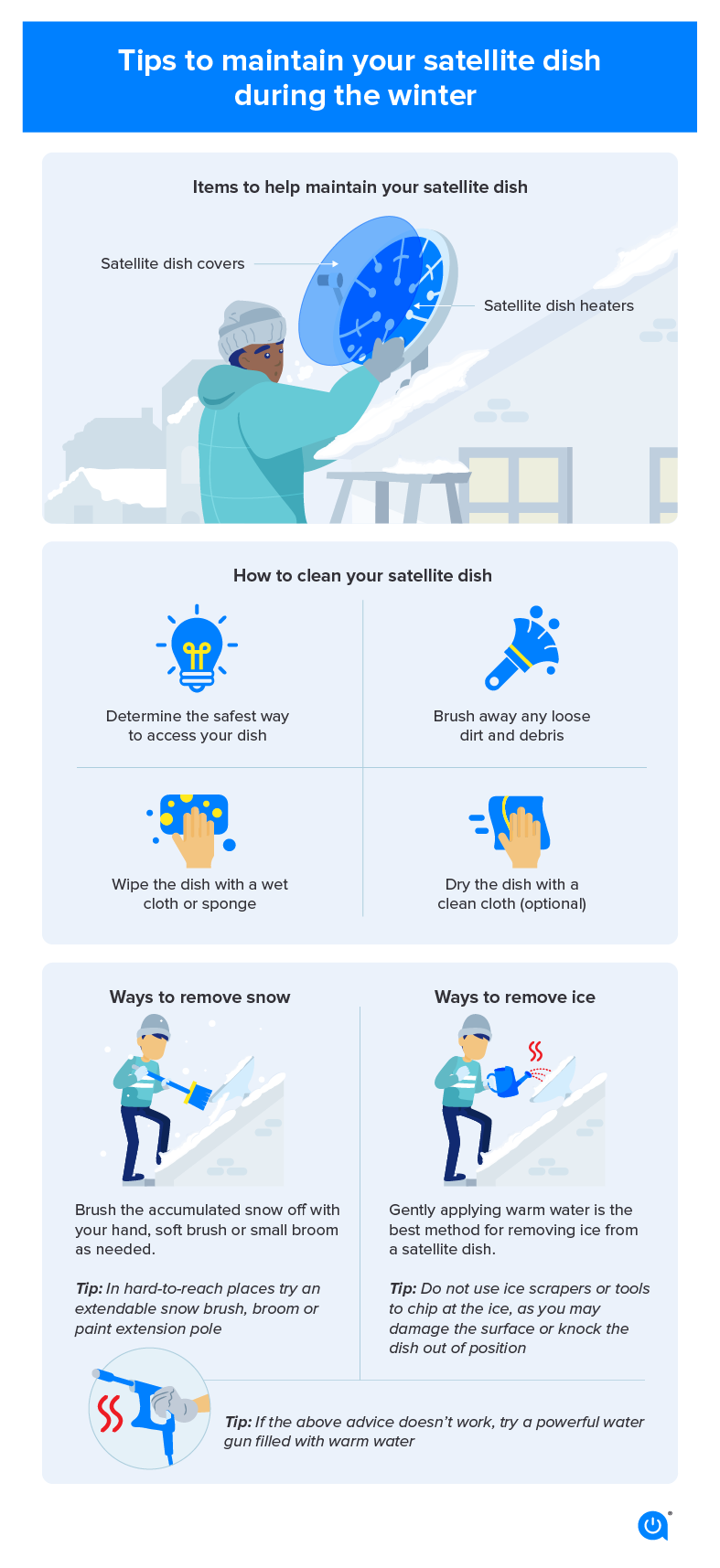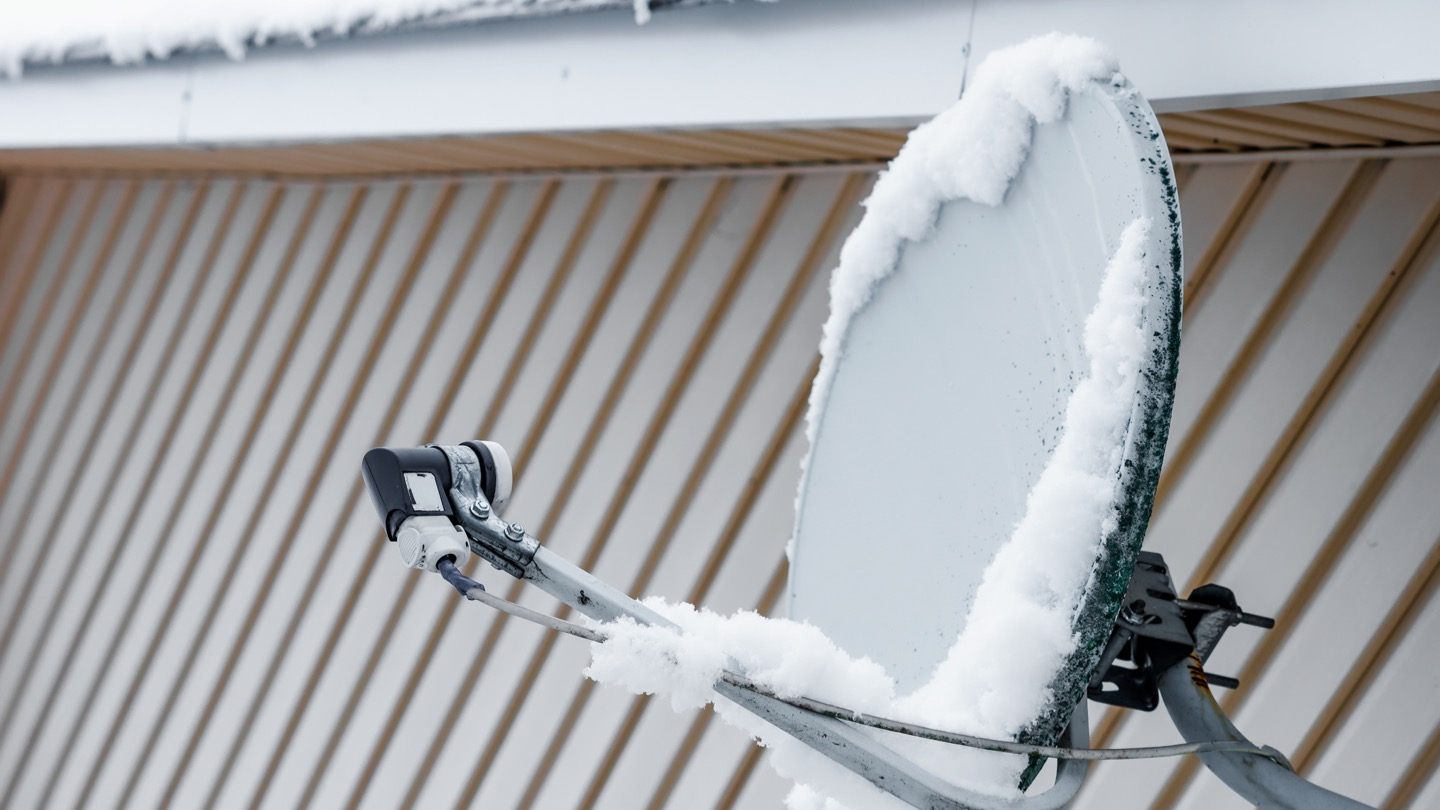If you have satellite internet or satellite TV service, you know that the occasional storm can interfere with your signal, but what about other things, like snow, ice and dirt? While they’re less prone to disrupt satellite service like heavy rain, snow and debris can impact signal quality.
Unlike a passing storm, accumulations of snow and ice or dirt and grime may stick around for a while, making your satellite signal issues more than a temporary inconvenience. To keep your satellite dish in ship shape, check out these tips for cleaning it and keeping it clear of snow and ice.
How to clean your satellite dish
Cleaning your satellite dish is similar to how you clean your TV screen. Be gentle with it, only clean it when absolutely necessary and don’t use any materials or chemicals that will damage the surface.
- Determine the safest way to access your dish – Roofs, eaves, railings and deck edges are common locations for satellite dishes. These spots keep your dish out of the way and make it less of an eyesore, but they can be difficult to reach. Decide on the safest way to access your satellite dish and use caution at all times.
- Brush away any loose dirt and debris – With a soft-bristle brush, lightly clean the dish to remove any larger debris such as leaves, bird droppings or top layers of dirt and pollen. Avoid any scrubbing as it may scratch the surface.
- Wipe the dish with a wet cloth or sponge – Wet your cloth or sponge in warm water (add mild dish soap or “green” window cleaner to the water if desired) and gently wipe the surface of the dish. Do not pour water or spray cleaning products directly on the dish. Let the water, soap and sponge do the work — “elbow grease” is not necessary when cleaning your satellite dish and will increase the risk of knocking it out of position.
- Dry the dish with a clean cloth (optional) – Drying the dish will help keep dirt and pollen from sticking to it immediately after you’ve cleaned it. Don’t fret over this step too much, though; the dish is bound to get wet again the next time it rains.
What to avoid when cleaning your satellite dish
You must use a light hand when cleaning the satellite dish; scrubbing or clearing with force could move the dish’s position. Don’t use any abrasive cleaning supplies like bleach or steel wool. Do not spray the dish or pressure wash it.
Is cleaning my satellite dish necessary?
Satellite dishes are built to be outside, so they can handle a buildup of dirt, pollen and remnants of where birds may have used the dish as a perch.
That said, some newer equipment, like Starlink dishes, requires a bit of maintenance to keep it at top performance. Follow the best practices and maintenance guides that come with your equipment.

How to get snow and ice off your satellite dish
Wintry conditions can make accessing your satellite dish even more problematic, so use extra caution when attempting to remove snow and ice.
It’s not necessary to clear snow or ice off your satellite dish unless you’ve lost signal. Snow accumulation is more likely to disrupt your satellite signal than ice, but thankfully, it’s also easier to remove.
Ways to remove snow
If you can safely access your satellite dish, simply brush the accumulated snow off with your hand, soft brush or small broom as needed.
For dishes that are a little harder to reach, try using a broom or paint extension pole to gently knock off the snow. An extendable snow brush is also handy for removing snow in hard-to-reach places.
If you can’t safely get within an arm’s or long pole’s reach of your dish, a powerful water gun loaded with warm water may be your best and most immediate solution. Aim directly at the dish and fire away until the snow is gone or your signal is back.
Remember that spraying water at your satellite dish comes with the risk of getting water into and possibly damaging internal components. Your satellite dish is made to shed water falling from the sky, not shooting up from below.
Ways to remove ice
Gently applying warm water is the best method for removing ice from a satellite dish. Do not use ice scrapers or tools to chip at the ice as you may damage the surface or knock the dish out of position. Moving it just a bit can mean the difference between a strong signal and no signal at all.
If you can safely access the dish, apply a light stream or coating of warm water until the ice melts. An empty spray bottle usually works best. Avoid pouring water on your satellite dish or hosing it down with the garden hose.
If you can’t get to the dish and are desperate to get your signal back before your college team’s tipoff, the water gun method detailed above may be your best option. In extremely cold environments, however, spraying your dish with water can add to the problem, that is if your water gun doesn’t freeze up first.
Clearing snow and ice from a satellite dish can be dangerous and at the very least, inconvenient, but the alternative of going without internet or TV until it melts isn’t very practical either. The best way to avoid snow and ice satellite signal interference is to prevent it from accumulating in the first place.
Maintaining your satellite dish
Modern satellite dishes are designed to shed snow and ice, but accumulations can still happen, especially in regions prone to heavy wintry weather. In these areas, accessorizing your dish with heaters or covers will help keep it clear of snow and ice all season long.
Satellite dish covers
Most dish covers are made of a fitted nylon material, creating a surface too smooth for significant snow and ice accumulation. Though less effective than dish heaters at keeping snow and ice from accumulating, dish covers are easy to install — slip it over the dish like a big sock — and are cheaper than most dish heaters.
Satellite dish heaters
Dish heaters, like the HotShot satellite dish heater, keep the surface of your dish above freezing temperatures. The automatic thermostat turns the heater on when needed and off when it’s not to keep energy consumption low. Most dish heaters do not require professional installation. These aren’t necessary unless you live in a colder and icier climate than most people.
Will cooking spray or Rain-X help prevent snow and ice accumulation?
Non-stick cooking and waterproofing sprays such as PAM or Rain-X are not recommended for keeping snow and ice off your satellite dish. These sprays can actually make it more likely to accumulate dirt and pollen, which then creates an ideal surface for snow and ice to accumulate. Furthermore, these chemicals could damage the surface of the dish. A good rule of thumb is if you wouldn’t spray your TV screen with it, don’t spray your dish with it either.
Will shielding my satellite dish from the rain keep the signal from going out?
Not likely. Placing a cover over your dish will help keep the rain from hitting it, but that isn’t what causes your signal to go out. Water can refract satellite signals anywhere along the path between the satellite in the sky and your dish. That’s why heavy rain and cloud coverage can disrupt your signal even when it’s not directly over your home.
Wrapping up
Only clean or clear off your satellite dish when it is absolutely necessary, and you can do it safely. If the risk is too great, wait until you can safely access the dish or have someone come out to service it. If your satellite service is still weak after cleaning, here are ways to boost your satellite’s signal strength as well.
Not satisfied with your current internet service provider? Enter your address to see if other internet service options like fiber or cable are available in your area.
Find more broadband news and studies on trends in the industry on Allconnect’s news hub and research hub.
Written by:
David AndersSenior Writer, Broadband Content
David joined the Allconnect team in 2017, specializing in broadband and TV content. His work has been referenced by a variety of sources, including ArcGIS, DIRECTV and more. As a Senior Writer, David is motivate…
Read more
Edited by:
Robin LaytonEditor, Broadband Content
-
Featured
![Amazon’s Project Kuiper launches first internet satellite prototypes]() Amazon’s Project Kuiper launches first internet satellite prototypes Camryn Smith — 2 min read
Amazon’s Project Kuiper launches first internet satellite prototypes Camryn Smith — 2 min read -
Featured
![What is Starlink? Everything you need to know about Elon Musk’s internet service]() What is Starlink? Everything you need to know about Elon Musk’s internet service Ari Howard — 4 min read
What is Starlink? Everything you need to know about Elon Musk’s internet service Ari Howard — 4 min read -
Featured
![Streaming vs. cable: Which TV service is better?]() Streaming vs. cable: Which TV service is better? Camryn Smith — 5 min read
Streaming vs. cable: Which TV service is better? Camryn Smith — 5 min read
Latest
-
Thursday, April 18, 2024
Comcast introduces new pre-paid internet, mobile and streaming plansRobin Layton — 2 min read
-
Thursday, April 18, 2024
T-Mobile imposes data cap of 1.2TB/mo.Robin Layton — 2 min read
-
Thursday, April 18, 2024
What is a portable Wi-Fi hotspot?Robin Layton — 6 min read





